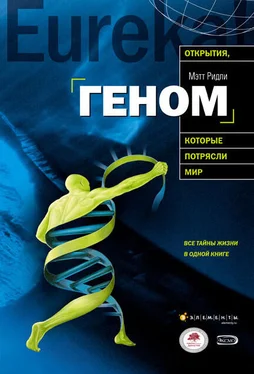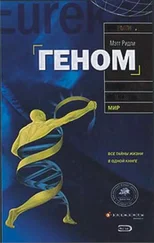Slagboom P. E., Droog S., Boomsma D. I. 1994. Genetic determination of telomere size in humans: a twin study of three age groups. American Journal of Human Genetics 55: 876–882.
Lingner J. et al. 1997. Reverse transcriptase motifs in the catalytic subunit of telomerase. Science 276: 561–567.
Clark M. S., Wall W. J. 1996. Chromosomes: the complex code . Chapman and Hall, London.
Harrington L. et al. 1997. A mammalian telomerase-associated protein. Science 275: 973–977;
Saito T. et al. 1997. Comparative gene-mapping of the human and mouse TEP1 genes, which encode one protein component of telomerases. Genomics 46: 46–50.
Bodnar A. G. et al. 1998. Extension of life-span by introduction of telomerase into normal human cells. Science 279: 349–352.
Niida H. et al. 1998. Severe growth defect in mouse cells lacking the telomerase RNA component. Nature Genetics 19: 203–206.
Chang E., Harley C. B. 1995. Telomere length and replicative aging in human vascular tissues. Proceedings of the National Academy of Science of the USA 92: 11190–11194.
Austad S. 1997. Why we age . John Wiley, New York.
Slagboom P. E., Droog S., Boomsma D. I. 1994. Genetic determination of telomere size in humans: a twin study of three age groups. American Journal of Human Genetics 55: 876–882.
Ivanova R. et al. 1998. HLA-DR alleles display sex-dependent effects on survival and discriminate between individual and familiar longevity. Human Molecular Genetics 7: 187–194.
Austad S. 1997. Why we age . John Wiley, New York.
Feng J. et al. 1995. The RNA component of human telomerase. Science 269: 1236–1241.
Holm V. et al. 1993. Prader-Willi syndrome: consensus diagnostic criteria. Pediatrics 91: 398–401.
Angelman H. 1965. ‘Puppet’ children. Developmental Medicine and Child Neurology 7: 681–688.
McGrath J., Solter D. 1984. Completion of mouse embryogenesis requires both the maternal and paternal genomes. Cell 37: 179–183;
Barton S. C., Surami M. A. H., Norris M. L. 1984. Role of paternal and maternal genomes in mouse development. Nature 311: 374–376.
Haig D., Westoby M. 1989. Parent-specific gene expression and the triploid endosperm. American Naturalist 134: 147–155.
Haig D., Graham C. 1991. Genomic imprinting and the strange case of the insulin-like growth factor II receptor. Cell 64: 1045–1046.
Dawson W. 1965. Fertility and size inheritance in a Peromyscus species cross. Evolution 19: 44–55;
Mestel R. 1998. The genetic battle of the sexes. Natural History 107: 44–49.
Hurst L. D., McVean G. T. 1997. Growth effects of uniparental disomies and the conflict theory of genomic imprinting. Trends in Genetics 13: 436–443;
Hurst L. D. 1997. Evolutionary theories of genomic imprinting. In: Reik W., Surani A. (eds), Genomic imprinting , p. 211–237. Oxford University Press, Oxford.
Horsthemke B. 1997. Imprinting in the Prader-Willi/Angelman syndrome region on human chromosome 15. In: Reik W., Surani A. (eds), Genomic imprinting , p. 177–190. Oxford University Press, Oxford.
Reik W., Constancia M. 1997. Making sense or antisense? Nature 389: 669–671.
McGrath J., Solter D. 1984. Completion of mouse embryogenesis requires both the maternal and paternal genomes. Cell 37: 179–183;
Barton S. C., Surami M. A. H., Norris M. L. 1984. Role of paternal and maternal genomes in mouse development. Nature 311: 374–376.
Jaenisch R. 1997. DNA methylation and imprinting: why bother? Trends in Genetics 13: 323–329.
Cassidy S. B. 1995. Uniparental disomy and genomic imprinting as cause of human genetic disease. Environmental and Molecular Mutagenesis 26: 13–20;
Kishino T., Wagstaff J. 1998. Genomic organisation of the UBE3A / E6-AP gene and related pseudogenes. Genomics 47: 101–107.
Jiang Y. et al. 1998. Imprinting in Angelman and Prader-Willi syndromes. Current Opinion in Genetics and developments 8: 334–342.
Allen N. D. 1995. Distribution of pathenogenetic cells in the mouse brain and their influence on brain development and behaviour. Proceedings of the National Academy of Sciences of the USA 92: 10782–10786;
Trivers R., Burt A. 1999. Kinship and genomic imprinting. Results and problems in cell differentiation 25: 1–21.
Vines G. 1997. Where did you get your brains? New Scientist , 3 May: 34–39;
Lefebvre L. et al. 1998. Abnormal maternal behaviour and growth retardation associated with loss of the imprinted gene Mest . Nature Genetics 20: 163–169.
Pagel M. 1999. Mother and father in surprise genetic agreement. Nature 397: 19–20.
Skuse D. H. et al. 1997. Evidence from Turner’s syndrome of an imprinted locus affecting cognitive function. Nature 397: 19–20.
Diamond M., Sigmundson H. K. 1997. Sex assignment at birth: long-term review and clinical implications. Archives of Pediatric and Adolescent Medicine 151: 298–304.
Baldwin J. M. 1896. A new factor in evolution. American Naturalist 30: 441–451.
Schacher S. et al. 1988. cAMP evokes long-term facilitation in Aplysia neurons that requires new protein synthesis. Science 240: 1667–1669.
Bailey C. H., Bartsch D., Kandel E. R. 1996. Towards a molecular definition of long-term memory storage. Proceedings of the National Academy of Science of the USA 93: 12445–12452.
Tully T. et al. 1994. Genetic dissection of consolidated memory in Drosophila . Cell 79: 39–47;
Dubnau J., Tully T. 1998. Genetic discovery in Drosophila : new insights for learning and memory. Annual Review of Neuroscience 21: 407–444.
Silva A. J., Smith A. M., Giese K. P. 1997. Gene targeting and the biology of learning and memory. Annual Review of Genetics 31: 527–546.
Davis R. L. 1993. Mushroom bodies and Drosophila learning. Neuron 11: 1–14;
Grotewiel M. S. et al. 1998. Integrin-mediated short-term memory in Drosophila . Nature 391: 455–460.
Vargha-Khadem F. et al. 1997. Differential effects of early hippocampal pathology on episodic and semantic memory. Science 277: 376–380.
Читать дальше
Конец ознакомительного отрывка
Купить книгу





![Twelve Angel - Супер Ген Бога. Том 13 [1201-1300 главы]](/books/408699/twelve-angel-super-gen-boga-tom-13-1201-thumb.webp)
![Twelve Angel - Супер Ген Бога. Том 12 [1101-1200 главы]](/books/408700/twelve-angel-super-gen-boga-tom-12-1101-thumb.webp)
![Twelve Angel - Супер Ген Бога. Том 11 [1001-1100 главы]](/books/408701/twelve-angel-super-gen-boga-tom-11-1001-thumb.webp)
![Twelve Angel - Супер Ген Бога. Том 10 [901-1000 главы]](/books/408702/twelve-angel-super-gen-boga-tom-10-901-thumb.webp)
![Twelve Angel - Супер Ген Бога. Том 9 [801-900 главы]](/books/408703/twelve-angel-super-gen-boga-tom-9-801-900-glavy-thumb.webp)
![Twelve Winged Dark Burning Angel - Супер Ген Бога. Том 2 [101-200 главы]](/books/412125/twelve-winged-dark-burning-angel-super-gen-boga-tom-2-101-200-glavy-thumb.webp)
![Twelve Winged Dark Burning Angel - Супер Ген Бога. Том 1 [1-100 главы]](/books/412126/twelve-winged-dark-burning-angel-super-gen-boga-tom-1-1-100-glavy-thumb.webp)
